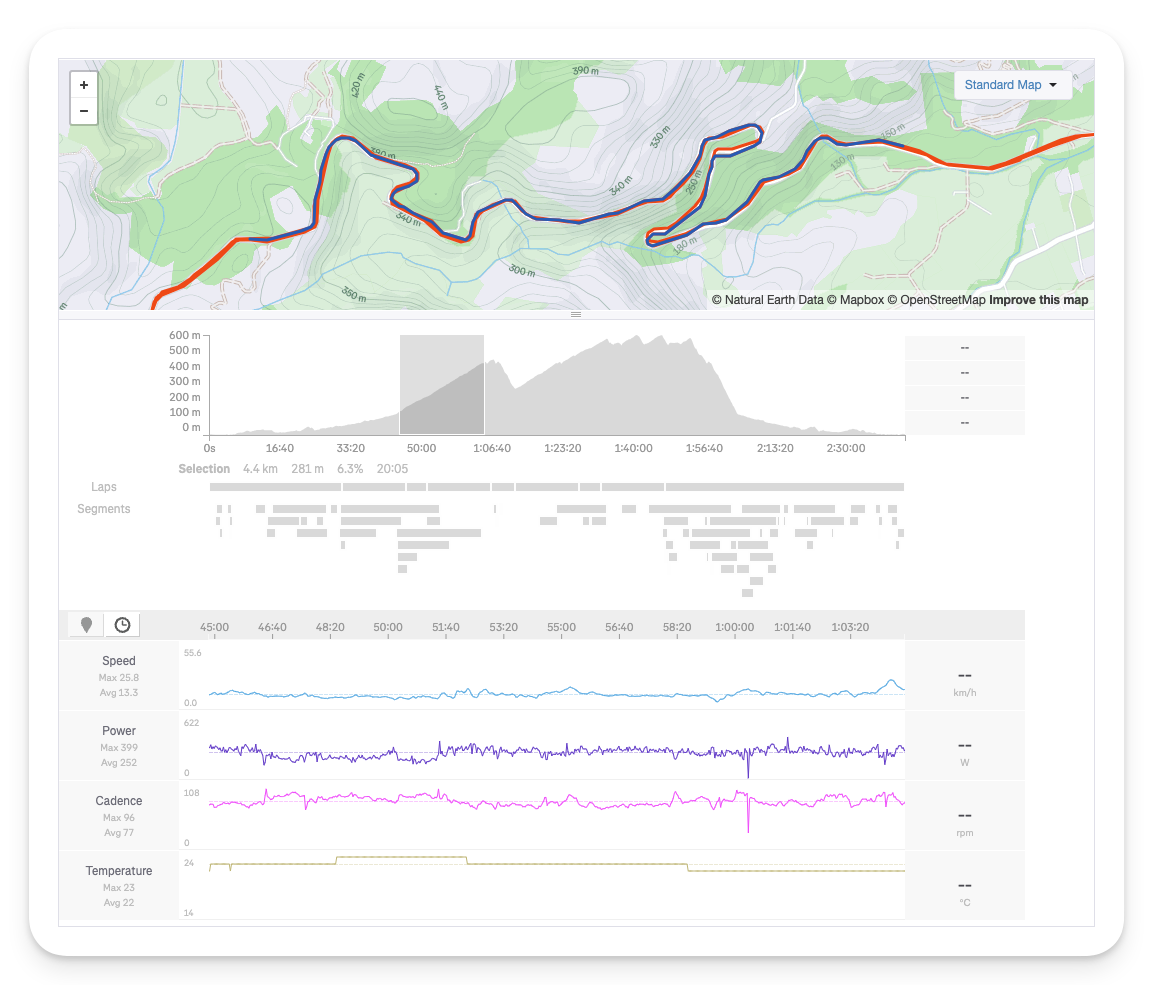Cycling Climbing Calculator
Calculate your climbing performance based on weight, bike weight, climb length, and elevation gain.
0.00km/h
Average Speed
0.00W
Average Power
0.00W/kg
Average Power per kg
Planning a race? Upload your GPX for personalized time predictions →
Get Weekly Training Tips
Join our newsletter for expert insights, training advice, and performance tips delivered to your inbox.
No spam, unsubscribe anytime. We respect your privacy.
About the Cycling Climbing Calculator
Learn more about the calculator and its creator

Jonas
I have been a cyclist for over 10 years and I built this calculator to help cyclists like you and me with training and racing.
Bicycle Climbing Calculator Explained
For cyclists looking to improve their climbing performance, understanding the power required to ascend hills is crucial. Our cycling climbing calculator provides accurate results by considering multiple factors that affect a rider's performance on climbs.
Real-World Validation Test
To validate our calculator's accuracy, we compared it with real-world data from a power meter:
- Distance: 4.4 km
- Elevation Gain: 275 m
- Time: 20 minutes
- Rider Weight: 90 kg
- Power Meter Reading: 252 watts
- Calculator Output: 256 watts
The calculator's prediction matches the actual power meter reading within 4 watts, demonstrating its high accuracy.

Understanding Climbing Power
When cyclists climb, their average power output needs to overcome several forces. The total power required depends on the combined weight of the rider and bike, the climb's characteristics, and environmental conditions. For accurate calculations, we consider both the rider's body weight and a standard bike weight of approximately 10 kg.
How the Calculator Works
The bicycle climbing calculator uses physics principles to estimate the power required to climb a given slope. It considers four main forces that affect a cyclist during climbing:
1. Gravitational Force (P_gravity)
The primary force when climbing is gravity. The power needed to overcome gravity is:
P_gravity = g × gradient × M × speed
- g = 9.81 m/s² (gravitational constant)
- gradient = elevation gain / distance
- M = total mass (rider + bike)
- speed = distance / time (in m/s)
2. Rolling Resistance (P_rr)
The power needed to overcome the resistance between tires and road surface is a significant factor. Rolling resistance varies based on tire pressure, road surface quality, and the combined weight of rider and bike:
P_rr = C_rr × M × g × speed
- C_rr = 0.005 (typical rolling resistance coefficient for road bikes)
- M = total mass (rider + bike)
- speed = velocity in m/s
3. Air Resistance (P_air)
Wind resistance and air density play crucial roles in determining the power needed. A cyclist's position and frontal area significantly affect this component:
P_air = ½ × C_d × ρ × A × speed × v_effective²
- C_d = 0.88 (typical drag coefficient for cyclist)
- ρ = 1.225 kg/m³ (air density at sea level)
- A = 0.5 m² (typical frontal area)
- v_effective = speed relative to air (including wind speed)
4. Total Power Required
The total power is the sum of all three components, giving us the watts needed to maintain a specific average speed on the climb:
P_total = P_gravity + P_rr + P_air
Advanced Considerations
For the most accurate power estimates, our calculator considers variations in air density with altitude, the impact of wind speed on energy expenditure, and the relationship between rider position and aerodynamic drag. These factors significantly affect the power required for climbing segments.
Key Assumptions
- Bike weight is estimated at 10 kg (including basic accessories)
- Standard air density at sea level (adjusts for elevation)
- Typical aerodynamic values for road cycling position
- Good quality road bike tires and surface
- Efficient drive train maintenance
Factors Affecting Accuracy
- Actual air density (varies with altitude and weather)
- Road surface quality (affects rolling resistance)
- Rider position (affects aerodynamic drag)
- Bike aerodynamics and maintenance
- Temperature and humidity
- Actual wind conditions during the climb
Using the Calculator Effectively
- Enter your actual body weight (the calculator adds 10kg for bike and gear)
- Use precise distance and elevation measurements from GPS or maps
- Include headwind/tailwind if known (positive for headwind)
- Time should be your moving time, excluding stops
Pro Tips for Cyclists
- Use this calculator to estimate power when you don't have a power meter
- Compare different climbing routes to understand their relative difficulty
- Track your progress over time on the same climbs
- Use the watts/kg metric to compare your performance with others
- Consider using the calculator for pacing strategy on unknown climbs
- Factor in wind conditions for more accurate power estimates
Applications Beyond Power Estimation
Beyond power calculation, cyclists can use this tool to:
- Plan training intensity for climbing workouts
- Estimate energy expenditure for nutrition planning
- Compare different climbing segments
- Analyze the impact of weight changes on climbing performance
- Understand the effects of wind and weather on climbing effort
Frequently Asked Questions
How many watts do I need to cycle uphill?
The power (watts) needed to cycle uphill varies significantly based on several factors:
- Gradient matters most: A 5% gradient typically requires 2-3 times more power than flat terrain
- Weight is crucial: A 70kg rider might need:
- • 150-200W for a gentle 3-4% climb
- • 200-250W for a moderate 5-7% climb
- • 250-300W+ for steep 8-10% climbs
- Speed affects power: Doubling your speed requires approximately 8 times more power
- Duration matters: Sustainable power decreases with climb duration:
- • 20 minutes: ~95% of FTP
- • 1 hour: ~90% of FTP
- • 2+ hours: ~70-80% of FTP
Use our calculator to get a precise estimate for your specific climb, taking into account your weight, the climb's characteristics, and environmental conditions.
Related Calculators
Other helpful calculators for Cycling